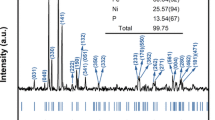Abstract
The magnetic behaviour and Curie temperatures (T C ) of spinelloids and spinels in the Fe3O4–Fe2SiO4 and Fe3O4–(Mg,Fe)2SiO4 systems have been determined from magnetic susceptibility (k) measurements in the temperature range −192 to 700 °C. Spinelloid II is ferrimagnetic at room temperature and the k measurements display a characteristic asymmetric hump before reaching a T C at 190 °C. Spinelloid V from the Mg-free system is paramagnetic at room temperature and hysteresis loops at various low temperatures indicate a ferri- to superparamagnetic transition before reaching the T C . The T C shows a non-linear variation with composition between −50 and −183 °C with decreasing magnetite component (X Fe3O4). The substitution of Mg in spinelloid V further decreases T C . Spinelloid III is paramagnetic over nearly the total temperature range. Ferrimagnetic models for spinelloid II and spinelloid V are proposed. The T C of Fe3O4–Fe2SiO4 spinel solid solutions gradually decrease with increasing Si content. Spinel is ferrimagnetic at least to a composition of X Fe3O4=0.20, constraining a ferrimagnetic to antiferromagnetic transition to occur at a composition of X Fe3O4<0.20. A contribution of the studied ferrimagnetic phases for crustal anomalies on the Earth can be excluded because they lose their magnetization at relatively low temperatures. However, their relevance for magnetic anomalies on other planets (Mars?), where these high-pressure Fe-rich minerals could survive their exhumation or were formed by impacts, has to be considered.
Similar content being viewed by others
Acknowledgments.
The samples investigated in this study were mostly synthesized or investigated under projects supported by the Deutsche Forschungsgemeinschaft (grants Ko 1514/1, Wo 652/1–2, Wo 652/4–1, AL 166/14–2). G. Brey (Universität Frankfurt) and D. Rubie (Bayerisches Geoinstitut) are thanked for access to their high-pressure facilities. R. Angel kindly provided the structural model of Fig. 4. R. Angel and C. McCammon are thanked for fruitful discussions pertaining to this work and T. Frederichs is thanked for his support and discussions during the stay of A. K. at the Institut für Marine Geophysik, Universität Bremen. We are grateful to an anonymous reviewer for his constructive comments.
Author information
Authors and Affiliations
Corresponding author
Rights and permissions
About this article
Cite this article
Kontny, A., Woodl, A. & Koch, M. Temperature-dependent magnetic susceptibility behaviour of spinelloid and spinel solid solutions in the systems Fe2SiO4–Fe3O4 and (Fe,Mg)2SiO4–Fe3O4 . Phys Chem Minerals 31, 28–40 (2004). https://doi.org/10.1007/s00269-003-0333-3
Received:
Accepted:
Issue Date:
DOI: https://doi.org/10.1007/s00269-003-0333-3




